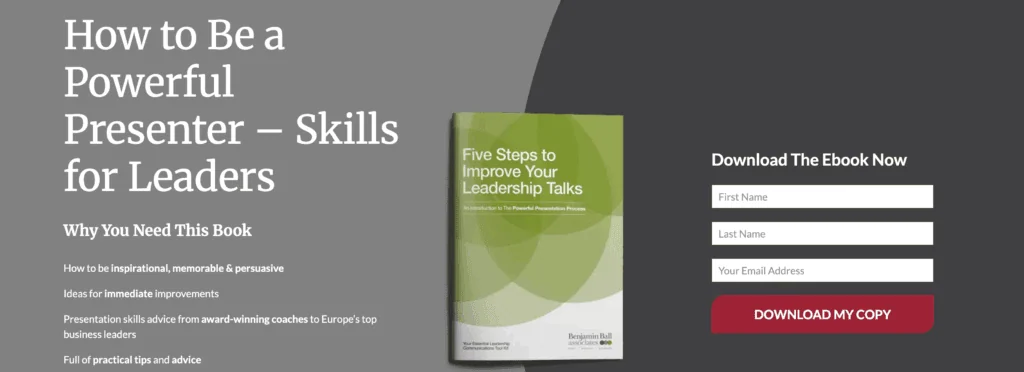
How to Write an Executive Summary: 9 Top Tips
September 26, 2024
What is an executive summary? How to write an executive summary that gets results? How do you write an executive summary for a report? What should be in your executive summary? How do you write an executive briefing?

Meet the Author: Benjamin Ball
Ben is the founder of Benjamin Ball Associates and leads the presentation coaching and pitch deck creation teams. Formerly a corporate financier in the City of London, for 20+ years he’s helped businesses win with better pitches and presentations, particularly investor pitches. He is a regular speaker and a guest lecturer at Columbia Business School and UCL London. Follow Ben on LinkedIn or visit the contact page.
Why Your Executive Summary Matters
Your executive summary is probably the most important part of any business report. For your reader – usually busy executives and decision-makers, this brief section often determines whether the rest of the report is worth reading.
When you craft it well, a great executive summary or executive briefing provides a concise, powerful overview of the entire report.
What is an Executive Summary?
When you write an executive summary you should think of it as a concise overview of a larger document, report or proposal. It highlights your key message and recommendations.
You should write your summary for someone who has little time and is reading this on the train or at home at the weekend – with all the family distractions around. That means it should be short, clear and interesting.
When you write a good executive summary, it can be the difference between your proposal gaining traction or getting lost in the noise. An effective summary sets the tone for the rest of your document and often determines whether your reader reads further. In particular:
- It gives key insights and essential information quickly.
- It highlights the main points in your document, such as objectives, recommendations, and conclusions, so that busy decision-makers can grasp the core message without reading the entire document.
- It’s no longer than one or two pages
- It should be clear, compelling, and tailored to your intended audience, emphasising what matters most to them.
Below you can read much more about how to write a powerful summary that gets noticed.
Write Better Executive Summaries
We’ve been coaching business executives in report writing skills for many years. Call us today to learn more about our business writing coaching.
Speak to an expert. Get a free consultation
Why is An Executive Summary of a Report So Important?
An effective executive summary serves as a concise yet powerful introduction to a project proposal, research report, or marketing plan. It should quickly convey your key objectives, and main takeaways to the target audience, whether they are potential investors, stakeholders, or decision-makers. In this way, your reader can quickly understand what you are proposing any why it is important.
What is the Purpose of an Executive Summary?
The purpose of an executive summary is to highlight the most critical aspects of a document without overwhelming your reader with detail. When writing a board report, a good executive summary is essential. A compelling executive summary should clearly define the specific problem being addressed, outline proposed solutions, and demonstrate the potential impact on the target market or market share. Using an executive summary example as a reference can help ensure clarity and conciseness.
For project managers and the management team, following best practice is essential. The summary should read like an elevator pitch, capturing interest whilst providing enough depth to encourage further reading. Whether you’re summarising a research paper or a business proposal, a well-structured executive summary increases engagement and improves decision-making efficiency.
Example of a Report Executive Summary
Here’s a good example of the executive summary from the Institute for Government:

Based on our 15 years’ of helping business executives write compelling business reports, here are clear tips showing how to write executive summaries so that you get the results you want with decision-makers.
How to Write an Executive Summary – Step by Step Guide
Your Executive Summary – What Should it Include?
1. Keep It Brief, But Powerful
An executive summary should be concise. In most cases, you should write no more than one page or about 10% of the total report length. Decision-makers don’t have the time to wade through lengthy summaries, so every sentence should add value.
How to Avoid Overloading
Start with the most critical information: What is the report’s purpose? What are the key findings? What actions do you recommend? Write clearly, avoiding jargon or technical language. Your goal should be to deliver a snapshot that conveys the report’s essence, not to summarise every detail. If a 15 year old can read your summary and understand it, you’ve written it well.
For example, instead of summarising each section at length, aim for a simple, high-level overview:
“This report recommends launching a new digital marketing strategy to increase customer acquisition by 20% over the next year, with an estimated ROI of 15%.”
By keeping it short and sharp, you make it easier for decision-makers to get the most important information upfront.
2. Start with a Strong Hook
Just like a good presentation, your summary opening should grab attention immediately. Decision-makers are often pressed for time, so you need to capture their interest from the start.
How to Hook Your Reader
Open with a compelling fact, statistic, or statement that highlights the significance of your report. This could be a problem that needs solving, an opportunity that could be seized, or a key insight that drives home why this report matters.
For example:
“With customer retention rates dropping by 10% over the past quarter, this report outlines a strategy to reverse the trend and boost customer loyalty.”
When you start with a strong hook, it shows that your report addresses a critical issue, encouraging decision-makers to keep reading.
3. Be Clear About the Key Message
The exec summary is not the place for details or tangents. One of the most common mistakes is trying to cram too much information into this section. Instead, work on conveying your key message clearly and succinctly.
How to Stay On Track
Identify the core objective of your report—whether it’s proposing a new initiative, evaluating a business strategy, or presenting financial findings—and make sure your summary revolves around it. Don’t get bogged down in details that distract from the main point.
For example, if your report is recommending a change in operational processes, stick to the benefits of that change:
“By implementing this streamlined process, we can reduce production time by 15% and lower costs by £200,000 annually.”
Stick to the big picture. Decision-makers want to know what you are proposing and why it matters, not how every part of it works or how much research you have done.
Why Pick Benjamin Ball Associates for Your Writing Coaching
At Benjamin Ball Associates, we’ve been coaching business people to improve their business communication skills for over 15 years. Our coaching is fast and effective. We work with individuals and with companies, one-to-one and in groups. Call us today to learn more.
“I honestly thought it was the most valuable 3 hours I’ve spent with anyone in a long time.”
Mick May, CEO, Blue Sky
Our most popular training courses include:
- Presentation Coaching
- Public Speaking Coaching
- Investor Pitch Support and Coaching
- Business and Report Writing Skills
Trusted by some of the most successful companies globally

Speak to Louise on +44 20 7018 0922 or email info@benjaminball.com to transform your speeches, pitches and presentations.
Speak to an expert. Get a free consultation
4. Use Clear, Direct Language
Executives are looking for quick, actionable insights. If your summary is filled with vague or convoluted language, you risk losing their interest or even causing confusion.
How to Use Clear Language
Write in a direct, active voice. Avoid jargon, buzzwords, and unnecessary technical terms unless they are essential to the report’s content. Even then, check that any technical terms are explained clearly. Short sentences are more effective in conveying your point quickly.
For example: Instead of writing: “The proposed strategy may potentially lead to an improvement in customer satisfaction, assuming all external factors align favourably.”
Write:
“This strategy should increase customer satisfaction by 10% within six months.”
Being clear and assertive in your language instils confidence in your recommendations. It makes your key message stick. Adding data points makes your proposal more specific and measurable.
5. Highlight Key Findings and Benefits
What should be in an executive summary of a report? An exec summary is more than just an introduction—it should also summarise the key findings that support your recommendation. Decision-makers are looking for evidence that backs up your conclusions and the benefits of acting on your proposal.
How to Highlight Key Insights
Select the most important data points or insights from your report to reinforce your argument. If your report includes financial forecasts, market research, or operational insights, choose the most compelling statistics to include in the summary.
For example:
“Customer feedback shows that 85% of users would prefer a more streamlined digital experience, suggesting strong demand for our proposed website upgrade.”
By weaving key findings into your executive summary, you make it clear that your recommendations are based on solid evidence, which increases your report’s credibility.
6. Offer Clear, Actionable Recommendations
The most effective executive summaries don’t just present problems—they offer solutions. Your summary should clearly outline the actions you recommend and the expected outcomes.
How to Make Recommendations Clear
Be specific about what action you are proposing and provide a sense of urgency or a timeframe where appropriate. If your recommendations involve investment, new strategies, or changes in operations, give a clear indication of the next steps.
For example:
“We recommend approving a £100,000 investment in our digital transformation project within the next quarter to capitalise on this market opportunity.”
This approach leaves no ambiguity, giving decision-makers a clear path forward and making your report more likely to lead to action.
7. Check That the Summary Stands Alone
While the executive summary is part of a larger report, it should also be able to stand alone. In many cases, decision-makers may only have time to read the summary, so it’s essential that it makes sense without having to refer to the full report.
How to Make Your Summary Self-Sufficient
Avoid referencing specific sections of the report that require the reader to flip back and forth. Instead, provide all the essential context in the summary itself. For instance, if you mention data, summarise the finding briefly without telling the reader to “see Appendix A” for more detail.
For example: Instead of writing: “As detailed in Section 2, our financial analysis indicates…”
Write:
“Our financial analysis indicates that this initiative could lead to a 15% increase in revenue over the next year.”
This makes sure that even if decision-makers don’t read the entire report, they still understand your key message and the logic behind it.
8. Conclude With a Strong Call to Action
Your executive summary should close with a clear, strong call to action. What do you want the decision-maker to do after reading it? Whether it’s approving a new strategy, investing in a project, or considering further research, make the next steps explicit.
How to End with Impact
A well-defined call to action gives your executive summary a sense of urgency and directs decision-makers toward immediate action. Be firm and specific.
For example:
“We recommend that the board approve the proposed expansion plan by the end of Q4 so that we capture this market opportunity.”
A strong call to action increases the chances of your report being taken seriously and acted upon.
9. Include Key Sections using an Executive Summary Template
This is a template structure you can use for your executive summary. This will help you decide what should be in your executive summary:
- Purpose: Briefly explain the document’s objective, the problem it addresses, and its significance
- Problem/Opportunity: Describe the issue that the document aims to solve or the opportunity it highlights
- Solution/Recommendations: Outline the proposed solution or actionable suggestions based on the findings
- Key Findings: Summarise essential data, arguments, or insights that support the recommendations
- Value/Benefits: Explain the value and impact of the proposed solution or actions
- Conclusion: Summarise the main points and emphasise the importance of the work.
10. Edit Ruthlessly for Clarity and Precision
Once you’ve drafted your summary, it’s essential to refine it. Many business professionals make the mistake of rushing through this final step, leaving their summary filled with unnecessary words or unclear phrasing. Instead, edit thoroughly.
How to Refine Your Summary
Go through each sentence and ask yourself if it contributes to the clarity and impact of the summary. Remove redundant phrases, simplify complex ideas, and make sure every sentence is as concise as possible. If you can say something in fewer words, do it.
For example: Instead of writing: “It is recommended that the marketing department undertakes efforts to improve our brand’s online presence.”
Write:
“We recommend launching an online marketing campaign to boost brand visibility.”
Editing ruthlessly helps your executive summary to be as clear and compelling as possible.
Make Your Executive Summary Count – Start Now
An effective summary is more than just a formality—it’s your chance to make a lasting impression on decision-makers. Mastering this skill makes sure that your reports don’t just inform—they influence.
If you’d like some help to improve your business writing skills, or if you’d like us to organise coaching at your firm, or to write your summary for you, speak to Louise Angus on +44 20 7018 0922 or click on the link below.
Speak to an expert. Get a free consultation
Why Choose Us:
Transform your pitches and presentations with tailored coaching

We can help you present brilliantly. Thousands of people have benefitted from our tailored in-house coaching and advice – and we can help you too.
“I honestly thought it was the most valuable 3 hours I’ve spent with anyone in a long time.”
Mick May, CEO, Blue Sky
For 15+ years we’ve been the trusted choice for leading businesses and executives throughout the UK, Europe and the Middle East. We’ll help you improve corporate presentations through presentation coaching, public speaking training and expert advice on pitching to investors.
Some recent clients

Unlock your full potential and take your presentations to the next level.
Speak to Louise on +44 20 7018 0922 or email info@benjaminball.com to transform your speeches, pitches and presentations.
Speak to an expert. Get a free consultation
FAQ: How to Write an Executive Summary
What is a Report Executive Summary?
Think of your executive summary is a brief yet comprehensive overview of a report, business plan or proposal. It highlights key points, including objectives, findings, and recommendations, allowing readers to grasp the main ideas quickly.
Why is an Executive Summary Important?
Busy decision-makers often don’t have time to read full documents. A well-written executive summary gives them the essential information that they need to make informed choices without reading every detail. When you make life easier for your reader, it’s more likely they will take the action you want.
How Long Should a Summary Be?
The ideal length varies depending on the document. The shorter the better. It is often one to two pages for a very long document. It should be concise while covering all the critical points.
What Should Be Included in an Executive Summary?
An executive summary should include:
– A clear purpose or problem statement
– Key findings or insights
– Proposed solutions or recommendations
– Any financial or operational highlights (if relevant)
– A strong closing statement that reinforces the importance of the document
What Tone and Style Should Be Used?
Your executive summary should be professional, direct, and easy to read. Avoid jargon, keep sentences clear and to the point and use bullet points where necessary to improve readability.
Should Your Summary Include Data and Figures?
Yes, but only the most relevant data. Summarise key figures or trends without overwhelming the reader with too much detail. If necessary, reference the full report for more in-depth analysis.
Where Does the Summary Go in a Document?
You should put it at the beginning, before the main content, so readers can quickly understand the key takeaways before diving into the full report.
What Are Common Mistakes to Avoid?
– Not getting to the point immediately
– Making it too long or overly detailed
– Using technical language that confuses the reader
– Leaving out key insights or recommendations
– Copying and pasting from the main document instead of summarising effectively
– Lengthy and word-dense executive summary slides
What are Business Report Writing Skills
Many of the skills in writing an executive summary are shared with business report writing skills. You can read more here how to write a powerful business report.
How Can I Make My Summary More Engaging?
Start with a compelling opening that highlights why the document matters. Put the most important information first. Use clear, confident language and make sure that every sentence adds value. A well-structured summary that flows logically will keep the reader’s attention.
What’s the Best Way to Review an Executive Summary?
After writing, step away for a short time, then read it again with fresh eyes. Ask a colleague for feedback and check it aligns with the main document’s key messages. Finally, check for clarity, grammar, and overall impact before finalising it.
If you want help writing high quality reports and summaries, get in touch. Our coaching will help your team be even more effective in their jobs.
Contact us now for free consultation
Start improving your pitches and presentations now
Contact us now and speak to an expert about getting award-winning coaching, training and advice
